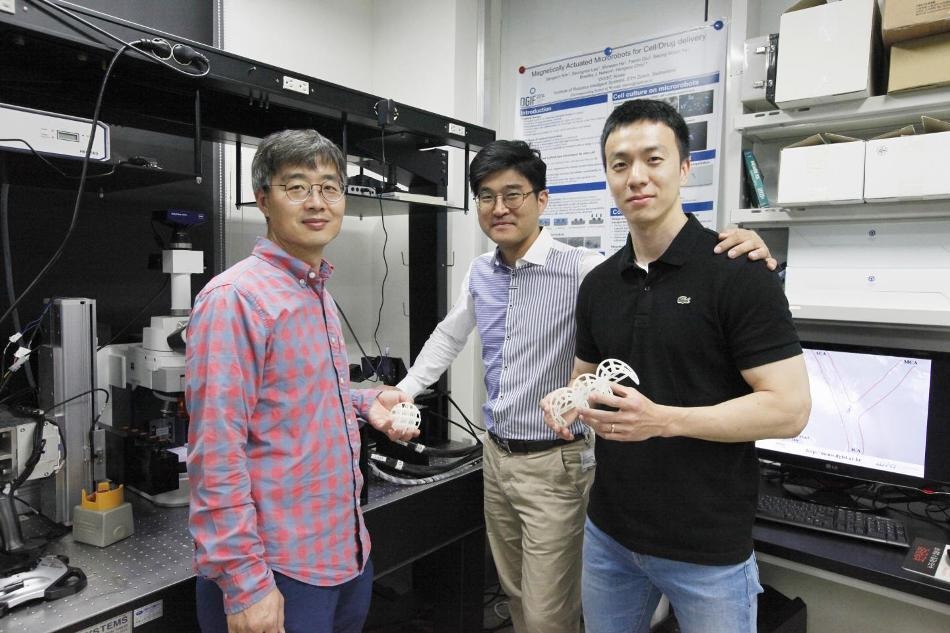Jun 18 2019
A Daegu Gyeongbuk Institute of Science and Technology (DGIST) research team has successfully developed stem cell delivery of scaffold microrobot that can exactly deliver cells to a target body tissue. This research accomplishment is projected to improve the treatment efficiency and safety of degenerative neural disorders as it can precisely transplant the precise amount of stem cell-based treatment cells to human body organs and tissues.
 Professor Hongsoo Choi in the DGIST Department of Robotics Engineering (left), 1st author and Ph.D. student Seong Woong Jeon (right), Senior Researcher Jin-young Kim at DGIST-ETH Microrobot Research Center (middle). (Image credit: DGIST)
Professor Hongsoo Choi in the DGIST Department of Robotics Engineering (left), 1st author and Ph.D. student Seong Woong Jeon (right), Senior Researcher Jin-young Kim at DGIST-ETH Microrobot Research Center (middle). (Image credit: DGIST)
DGIST recently reported that Professor Hongsoo Choi’s team in the Department of Robotics Engineering built a “scaffold microrobot for stem cell delivery and transplantation,” which can further improve the current treatment efficiency of stem cell. A collaborative international research was carried out with Senior Researcher Jin-young Kim at DGIST-ETH Microrobot Research Center, Professor Seong-Woon Yu and Professor Cheil Moon’s team in the Department of Brain and Cognitive Sciences, Professor Sung Won Kim’s team in Seoul St. Mary’s Hospital, and Professor Bradley J. Nelson’s team in the Institute of Robotic and Intelligent Systems at ETH, Zurich, Switzerland.
Stem cell treatment has been taking center stage as a regenerative medical method for intractable disorder treatment, but it cannot transplant the precise amount of stem cells to the target areas in need of treatment deeply within the body or may have an injection risk. It has especially been highlighted that treatment efficiency and safety are low because of massive loss during the in vivo delivery of stem cells and costly treatment.
To surpass such constraint, the DGIST research team developed scaffold microrobot in a helical and spherical type through the 3D laser lithography. The biggest accomplishment of this study is that it reduced cell loss in the body via a wireless control technique using an external magnetic field while transplanting stem cells rapidly and precisely all at once.
The remarkable aspect is that while the prevalent researches tested microrobots in a static external setting and not physiological setting, this study cultured a hippocampal neural stem cell on a microrobot for the first time ever. They split the cell into specific cells such as oligodendrocyte, astrocyte, and neuron and succeeded in exactly delivering and transplanting them in the target.
To achieve this feat, the research team demonstrated the cell transfer and transplantation process using the microrobot inside Body-on-a-chip (BOC), a microfluidic cell culture system that simulated a physiological in vivo environment. A rat’s brain was extracted by them and the microrobot was injected into the internal carotid artery and transferred to the anterior cerebral artery and middle cerebral artery with the help of an outer magnetic field. An outstanding feature of this collaborative research is that they cultured the “hNTSCs10” given by Professor Sung Won Kim’s team at the Catholic University St. Mary’s Hospital on the microrobot in 3D for fruitful testing.
Through this research we hope to increase the treatment efficiency and success rate for Alzheimer and central neural diseases, which couldn’t be approached through the existing method of stem cell treatment. Through continuous follow-up research with hospitals and related companies, we will do our best to develop a microrobot-based precise treatment system that can be used in actual hospital and clinical sites.
Hongsoo Choi, Professor, Department of Robotics Engineering, DGIST
This experiment result was reported in the May 30th issue of “Science Robotics,” a leading international journal in robot research field and the sister magazine of “Science,” a popular scientific journal. This study was also aided by the Ministry of Science and ICT and the Ministry of Trade, Industry, and Energy.